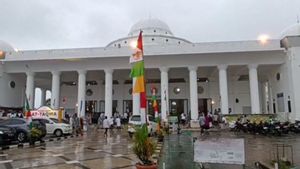JAKARTA - Head of the Jabodetabek Transportation Management Agency (BPTJ) Polana Banguningsih Pramesti stated, there is an imbalance in traffic density which is increasing with the growth of transportation infrastructure.
Polana's statement was in response to Tomtom's survey results which stated that the congestion rate in Jakarta had not decreased in the past year.
Judging on its official website, in 2018, Tomtom said that Jakarta's congestion rate was 53 percent. In 2019, congestion levels have stagnated at the same rate. In fact, the odd-even system has been in effect since September 2019.
"The number of vehicles passing Jakarta in 2015 was around 47 million. Now, it has almost doubled, around 88 million. Meanwhile, the addition of infrastructure is not linear," said Polana when contacted, Friday, January 31.
Polana said, there are several policies that can be carried out by the DKI Jakarta Provincial Government to reduce the number of congestion in addition to implementing odd-even on 25 highways.
First, the odd-even application at toll gates is extended to all toll roads coming from Bekasi, Tangerang and Bogor. The aim is to reduce the number of vehicles entering from the buffer zone.
"Odd-even at toll booths is implemented, but it is supported by the integration of premium mass buses. Toll users are the average private vehicle users who are willing to pay more to get to their destination," said Polana.
Then, the Governor of DKI Jakarta must accelerate the implementation of the electronic road pricing (ERP) system. In addition, increase the reach of integrated mass public transportation.
In fact, the vehicle reduction plans are all contained in the Jakarta Transportation Master Plan (RITJ). However, not everything has been carried out because the RITJ has only started since mid-2018.
"In the first phase until the end of 2019 yesterday, we are evaluating how much RITJ has achieved. However, it will take time. Hopefully this year there will be progress," he said.
For information, the Tomtom survey in 2019 involved at least 416 cities from 57 countries on six continents. His research involves various elements such as motorists, government policies, urban planning, to vehicle production.
The first rank with the highest congestion rate is in Bengaluru, India with a congestion rate of 71 percent. Second, Manila, the Philippines with a congestion level of 71 percent. Third, Bogota, Colombia with a congestion rate of 68 percent.
Meanwhile, Jakarta is in the tenth position of the most congested cities in the world. The congestion rate in Jakarta has not decreased, but its ranking has decreased from 2018 which was ranked 7. The decrease in congestion ratings was due to the addition of 13 new cities surveyed by Tomtom. As of 2018, there were 403 surveyed and 2019 increased to 416.
Of the 13 cities that have just been added, three of them immediately overtook a higher level of congestion than Jakarta. These cities include Bengaluru from India, Manila from the Philippines, and Pune from India.
In the official Tomtom website, it also mentions that the congested time in Jakarta in 2019 occurred on Friday, 17.00-18.00 WIB. He asked Jakarta residents to avoid that time for driving comfort.
Also, in 2019, the day of the least traffic jam is June 4. This day coincides with the Eid al-Fitr holiday when Jakarta residents are busy doing their homecoming to their hometowns. Then, for the most congested day during the year falls on March 6, 2019. The level of congestion even reaches 91 percent. Even though the average in one year is 53 percent.
Other data shows that during working hours, Monday morning is the most congested time of the day. Meanwhile, at night, Friday is the most congested time with an average of more than 90 percent.
The English, Chinese, Japanese, Arabic, and French versions are automatically generated by the AI. So there may still be inaccuracies in translating, please always see Indonesian as our main language. (system supported by DigitalSiber.id)













